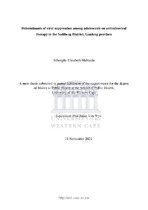| dc.contributor.advisor | Van Wyk, Brian | |
| dc.contributor.author | Mabizela, Sibongile Elizabeth | |
| dc.date.accessioned | 2022-02-21T12:22:50Z | |
| dc.date.available | 2022-02-21T12:22:50Z | |
| dc.date.issued | 2021 | |
| dc.identifier.uri | http://hdl.handle.net/11394/8717 | |
| dc.description | Magister Public Health - MPH | en_US |
| dc.description.abstract | Approximately 1.75 million adolescents (10-19 years old) globally were living with human immunodeficiency virus (HIV) in 2020, with the Eastern and Southern African regions the most affected by HIV. Progress has been made to increase access to antiretroviral therapy (ART) for adolescents living with HIV (ALHIV) to improve their survival. However, ALHIV still have worse treatment adherence and viral suppression compared to adults and children. This is in part because routine monitoring of HIV treatment programmes does not report for ALHIV; thus making their lack of progress in ART not visible. It is imperative to determine viral suppression and the factors that are associated with viral suppression among adolescents to assess treatment outcomes at local service levels. | en_US |
| dc.language.iso | en | en_US |
| dc.publisher | University of Western Cape | en_US |
| dc.subject | HIV/AIDS | en_US |
| dc.subject | Antiretroviral therapy | en_US |
| dc.subject | Virologic failure | en_US |
| dc.subject | Gauteng province | en_US |
| dc.subject | Adolescents | en_US |
| dc.title | Determinants of viral suppression among adolescents on antiretroviral therapy in the Sedibeng District, Gauteng province | en_US |
| dc.rights.holder | University of Western Cape | en_US |

